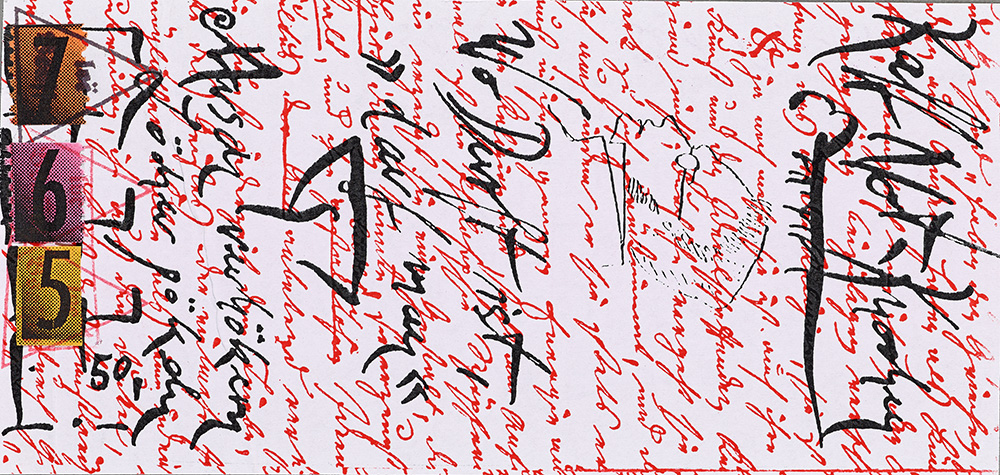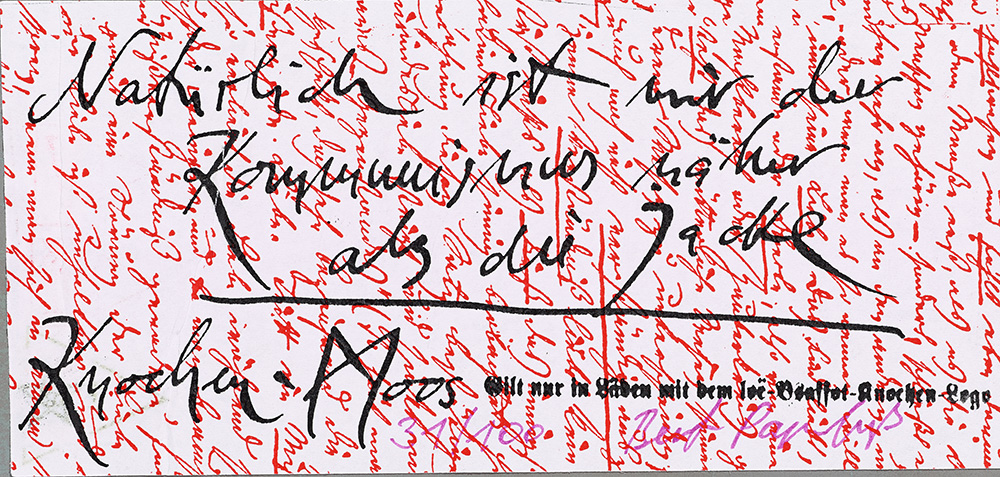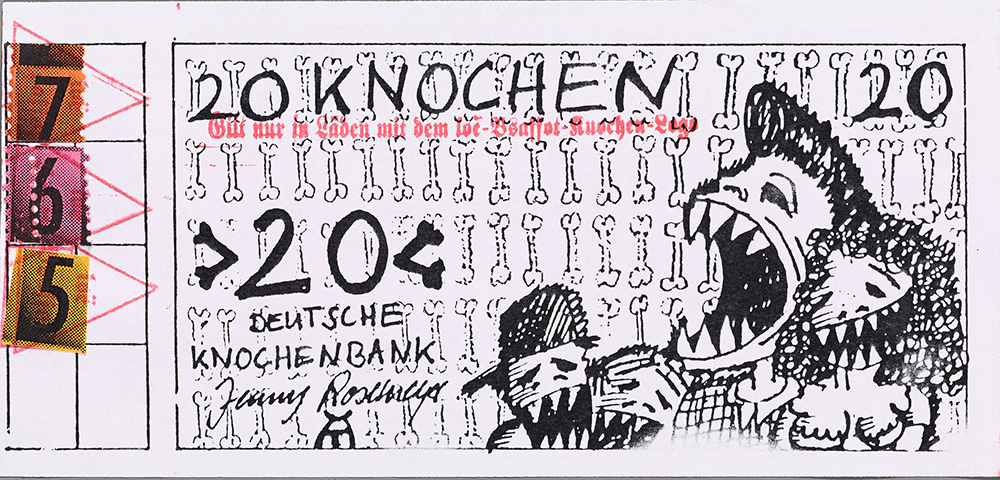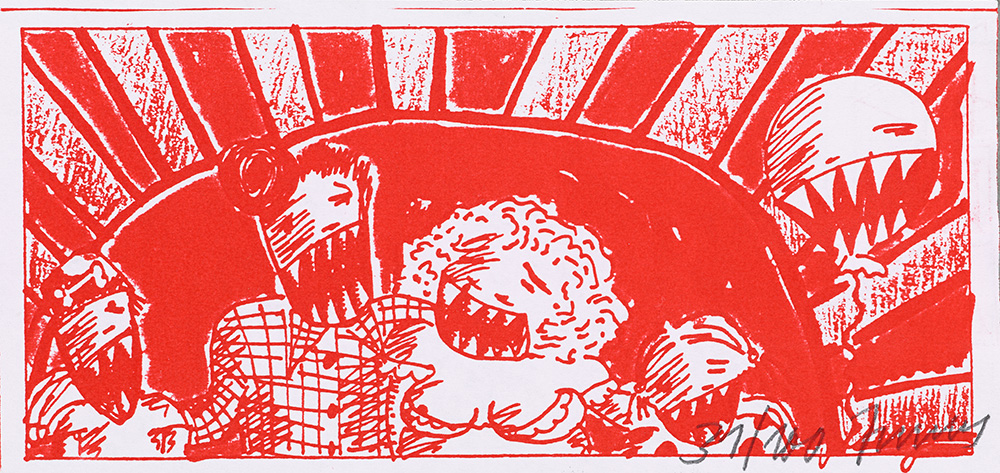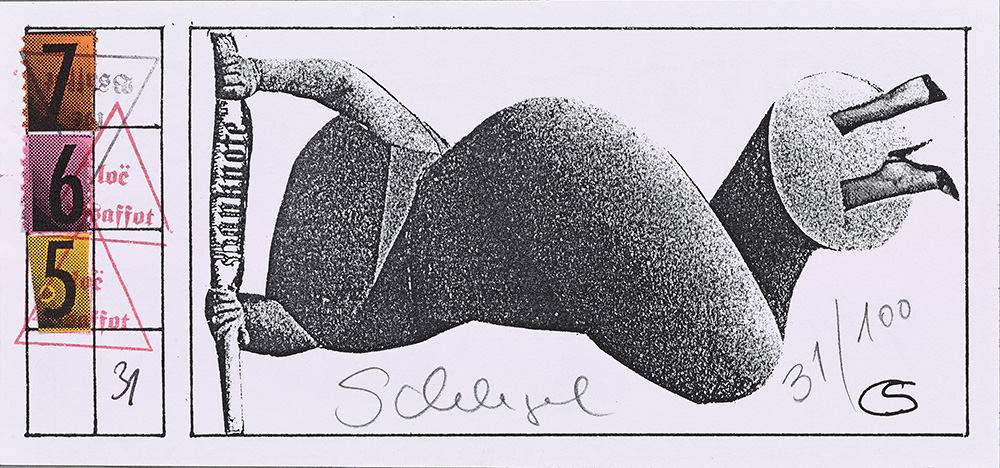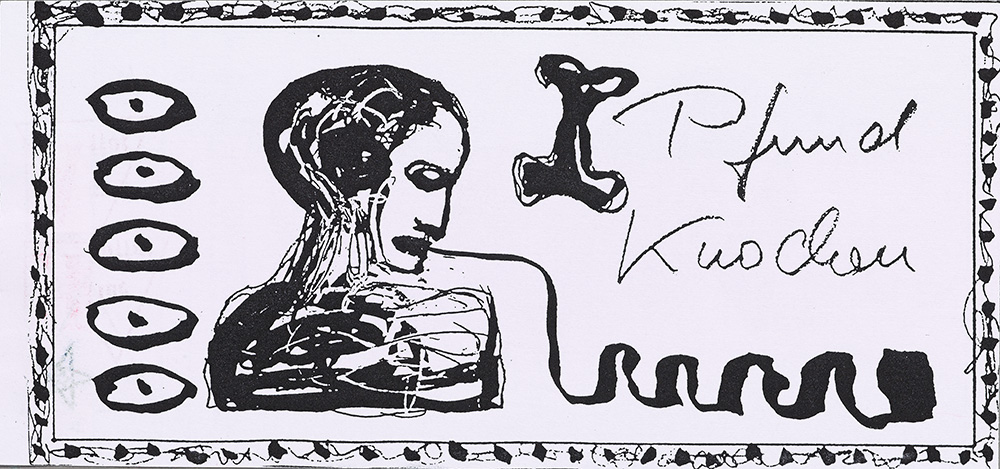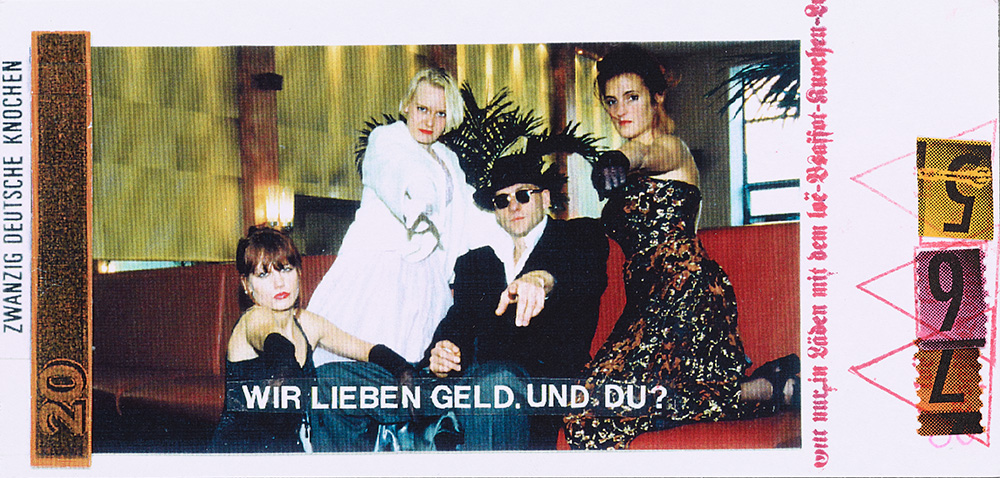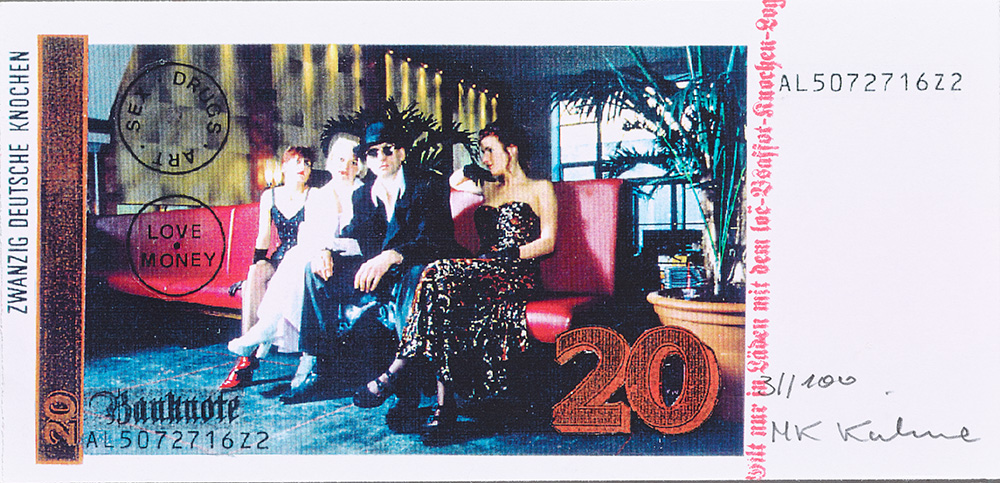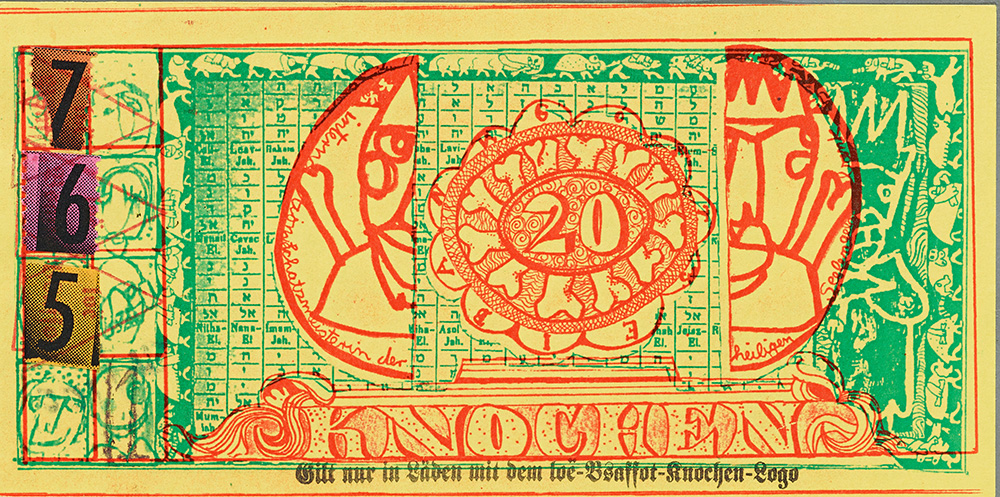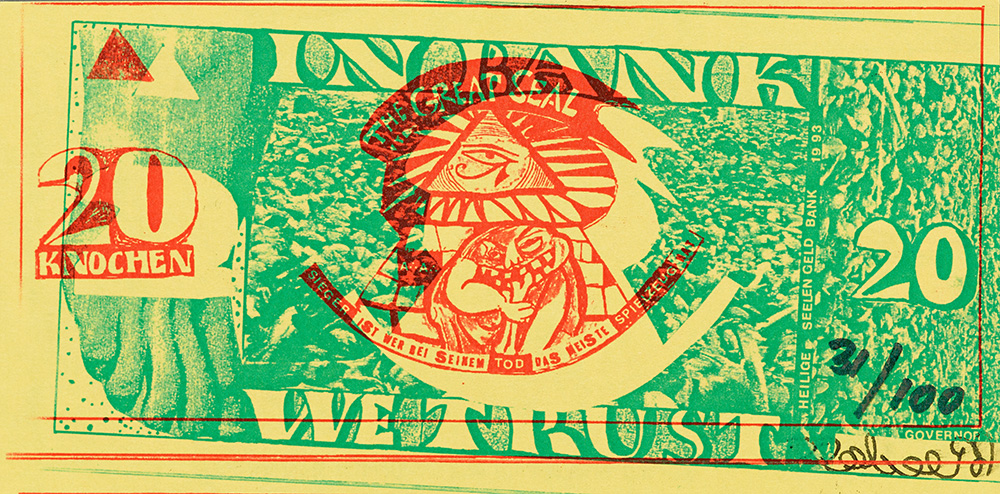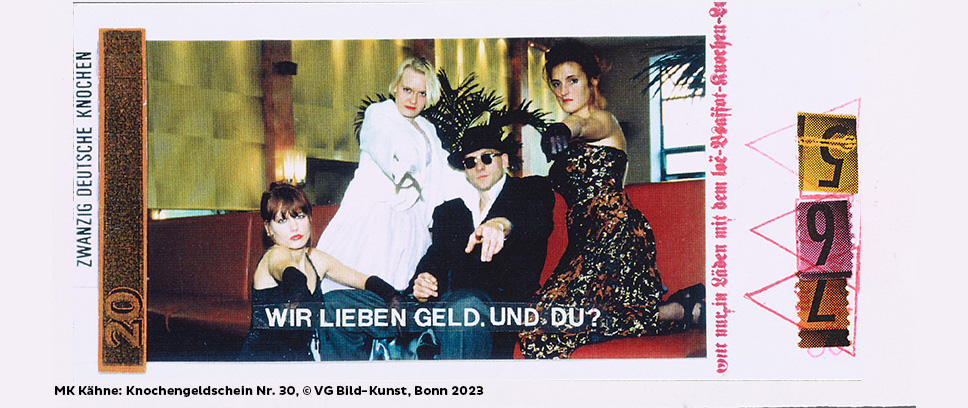
“Cash is scarce, money fleeting in a flash! Fight interest! Long live art money!” …
Lili Reyels | 28 December 2023
… thus it stood in the strategy paper1 of the group “Ioë Bsaffot” for their action “Bone money experiment – artists make money”, which the lyricist and poet Bert Papenfuss wrote.2 Dr Lili Reyels, head of the DHM collection on financial and economic history talks about this “art money”, which was launched 30 years ago as an art action in Berlin.
And so it happened some 30 years ago, in December 1993, that the question “Can you pay here with bones?” near Kollwitzplatz in Berlin and in parts of the district of Mitte could be answered with “Yes”. Three years after reunification, this happening was not meant as an anarchistic currency reform nor did it reflect annoyance with the new pan-German currency. Instead, it was about a humorously and cleverly staged art action of the gallery “o zwei” in Oderberger Strasse under the direction and organisation of the artist and gallerist Wolfgang Krause. The end effect was that the artists raised their name recognition and were able in a playful way to make people aware of the pressing need for money in their metier.
Altogether 55 individual art banknotes resulted from this get-together of international and German artists in East and West. Numbered consecutively and bound in a wad of bills by a bank wrapper, the notes were perfectly suited for collectors from the beginning and were sold as a complete set for 1,000 DM – in December 1993 to the Deutsches Historisches Museum as well. In this way the art notes arrived in the DHM’s financial and economic history collection. The gallery published the “bone banknotes” in its role as “Decentral Bank”. A normal photocopier served the artists as the “banknote printing press”, after which the notes were signed by hand. 100 copies of each of the artists’ bone notes were printed, so that the total emission value amounted to 106,000 DM.3
The validity of the bone notes
The bonus was that the “bones”, which were created a complementary currency or “free-money” (Freigeld), continually lost value. Following Silvio Gsell’s theory of depreciate money, this was aimed to prevent money-hoarding by collectors or art speculators. This is also where the name “bone money” came from, which refers to the philosopher Diogenes, who had suggested making money out of bones, because the dreadful smell created when the bones were stored would prevent hoarding. A contemporary observer puts it this way: “(G)enuine art is false money; when false money is put to use it becomes real money, whereby after art money’s inflationary depreciation vis-à-vis the DM, it can, of course, rise again in DM value after completion of the action.”4
The Swiss artist G.P. Adam created an original sticker for shops that accepted bone notes as a means of payment, including a bone logo announcing: “We accept bones.” And so it was possible to drop by the shop “allet mögliche” in Schliemannstrasse and buy the morning newspaper with bone notes, to take breakfast next door at the “Schliemann” café, to buy a record at “OM/Sounds” in Sretzkistrasse, and in the evening to pay for a beer at the “Pinte” in Lychener Strasse, all with bone money.5 Change was given in real money. The participating businesses could exchange the bone notes in the gallery for real money or keep the notes as artworks or capital investments. Two sample books were kept in the “Initiative Committee”, i.e. the gallery, to certify the authenticity of the art banknotes.
Themes of the bone notes
The themes of the art banknotes varied from the satirical to the ironic or the abstract – and they naturally often had to do with bones. Many of them exemplified the typical style of the artist.
The bone note designed by Bert Papenfuss, for example, bears the inscription on a red background: “Of course communism is closer to me than the jacket.” His art money is also decorated with self-devised letters and punctuation marks as well as the motto: “Wo Durft ist, ‘darf man’ etwas verhökern, Löcher pökeln” (roughly: “Where there’s need, ‘it is needed’ to hawk something, to pickle holes”). His wordplay is evident in the strategy papers as well as in the art banknote. With Papenfuss as an important representative of the underground art scene in the GDR, the art action also stands in the tradition of the GDR samizdat graphics and texts.6
A small party of laughing monsters with big teeth on Jenny Rosemeyer’s banknote seem to be wanting to devour the little bones. Perhaps they represent predatory capitalism, for the scene has something morbid about it.
Christine Schlegel chose the bust of a woman instead of the usual head of a politician to adorn her banknote. Five abstract eyes observe the woman from the side; she seems to be spitting something out. The motif of the bone appears on the reverse side in a twisted form, a photomontage. The feet are sticking out of the form.7
The artist MK Kähne found a theme for his banknote that he later often took up again: the idea of transposing social milieus and illustrating the theses in his work by means of persiflage. In these photos on the banknote, well-to-do, elegantly dressed people look out at the observer with a provocative expression and ask: “We love money. You, too?”
A few years after the bone money action, the artist Breeda CC sold her set of bone banknotes. From the proceeds she bought part of her vehicle for the mobile theatre “Icke Mobil”. On the note she wrote “In Bank We Trust”, a persiflage of the American slogan “In God We Trust” which by US law had to be printed on all American coins and banknotes from 1955 on. On the one hand, Breeda CC is taking an ironic-critical look at American capitalist society and on the other she negates the reference to God, whereby money is interpreted as an (ersatz)religion of our days in which one can safely place one’s trust.8
The end of the action
The term of the banknotes expired on 29 December 1993. After these seven weeks the “money” had value only as art. Therefore the central banks of the German states took no offense at the “Prenzlberger currency reform”. Since the funny money made no attempt to resemble real money, as the Federal Bank stated, it could not be considered counterfeit money. But on the other hand it was forbidden to forge the bone money, because the copyright of the artists would then be violated. At the beginning of 1994, the bone notes that had been circulated9 in November and December of 1993 were auctioned off for 80,000 DM.
N.B.: A longer version of this article on “bone money” is going to be published in the magazine “Geldgeschichtliche Nachrichten” 332 in March 2024.
Literature
Tannert, Christoph: Knochengeld, in: Krenzlin, Kathleen (ed): Wochenmarkt und Knochengeld, p. 122f, Berlin 2006
Küter, Alexa und Bernhard Weisser: Kunst prägt Geld. MUSE MACHT MONETEN. An exhibition of the Münzkabinett with loans from the Sammlung Haupt “Thirty Pieces of Silver – Art and Money”, Das Kabinett 16, Berlin 2016, pp. 153-156.
Steguweit, Wolfgang: Scheingeld zu 20 Knochen, in: Numismatisches Nachrichtenblatt 43, 1994, p. 20f.
Ioë Bsaffot: Strategiepapiere I bis V, Berlin 1993
1 Ioë Bsaffot: Strategiepapier II, Berlin d. 25.9.1993
2 The name of the group comes from the thieves’ argot term for “counterfeit notes” (Ioë = false or fake; Bsaffot = papers, ID, passport).
3 Küter, Alexa; Weisser, Bernhard: Muse macht Moneten, p. 154
4 Der Freitag, 12 November 1993, Nr. 46, Detlef Kuhlbrodt: Künstler drucken eigenes Geld.
5 Cf. report in the newspaper Telegraph, 12/1993: Lothar Feix: Verrückt – Prenzlberger drucken eigenes Geld, p. 10
6 Thanks to Mr Tom Riebe of POESIE SCHMECKT GUT e.V., Jena, for pointers. Cf. also: Kaiser, Paul und Claudia Petzold (eds.): Boheme und Diktatur in der DDR. Gruppen, Konflikte, Quartiere. 1970-1989. Catalogue of the exhibition in the Deutsches Historisches Museum from 4 September to 16 September 1997, Berlin 1997.
7 Interview with Christine Schlegel on 15.08.2023
8 The term for banknotes that were actually used for purchase is “gelaufene Scheine”.
